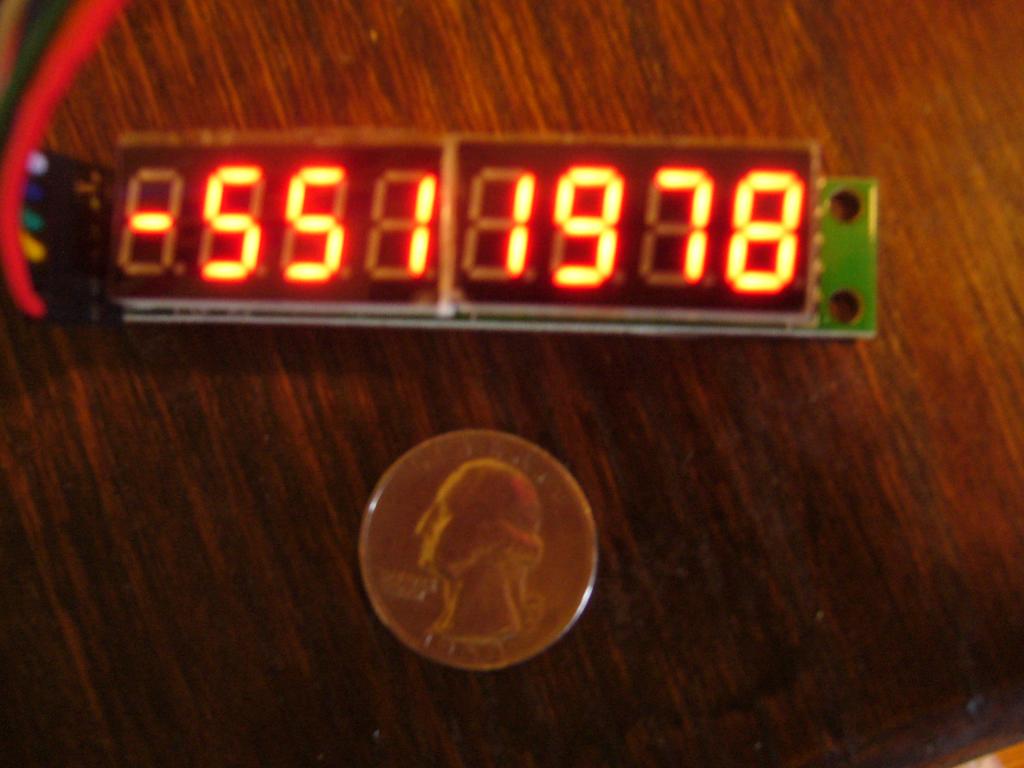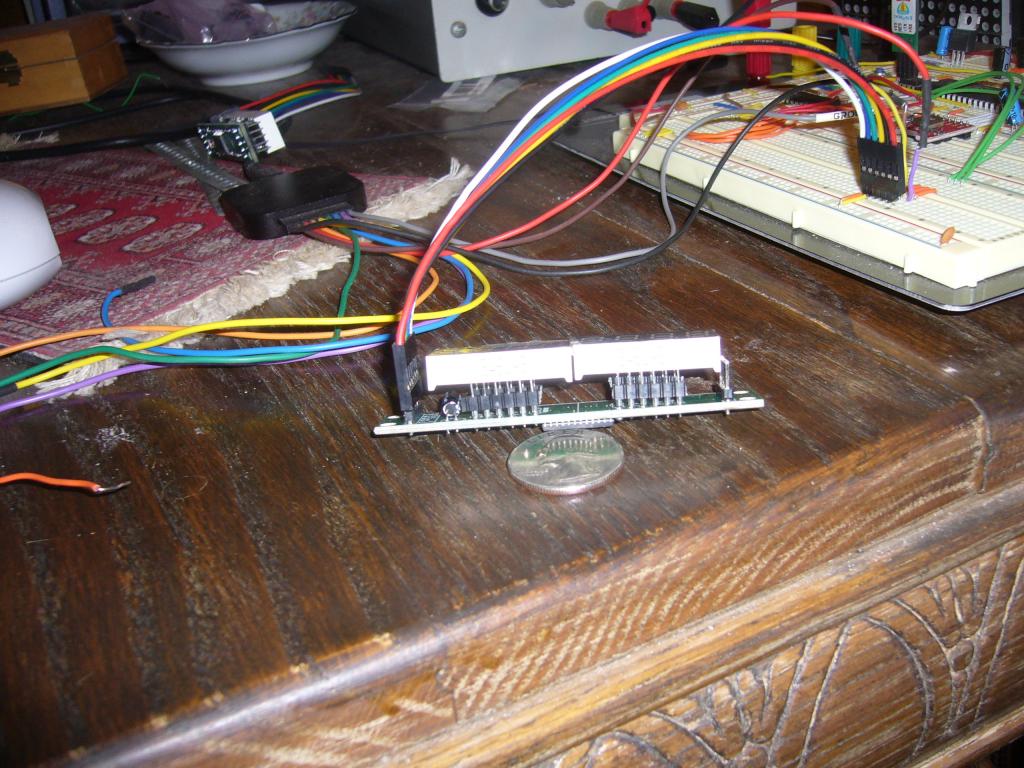Eight Digit Seven-Segment Display based on MX7219
 tomcrawford
Posts: 1,129
tomcrawford
Posts: 1,129
Here is an eight digit Seven-segment display based on MX7219 that recently appeared on eBay. They mostly come from China/Hong Kong and cost from $4.00 up, a little less in fives or tens. You can find plenty of them by searching MAX7219 Digital Tube (dont know where the tube part came from).
http://www.ebay.com/itm/New-MAX7219-8-Digit-Red-LED-Digital-Tube-Display-Module-Green-Board-For-Arduino-/281347153969?pt=LH_DefaultDomain_0&hash=item418198e031
It is based on the Maxim MX7219; here is a pointer to their data sheet.
http://www.maximintegrated.com/en/datasheet/index.mvp/id/1339
This module is different from the Seven-segment module discussed in some detail in this tread. That module used just shift registers and requires constant refreshing.
http://forums.parallax.com/showthread.php/157074-7-Segement-DisplayHelp-Needed
Here is a sample driver that generates random numbers in the range +-9,999,999, and calls a PASM cog to convert to BCD and write onto a single module.
Here are a couple of photos. The eBay ads all shown the module next to a metric scale but I'm enough native U.S. to not really get a good feeling for the actual size. One picture shows a module next to a good ol' USA quarter. The other shows how the LEDs are socketed. Don't know why they did that.
I will do some fiddling to drive multiple modules and post results in this thread. tc
PS: I think I now understand why the comsub instruction happened.
http://www.ebay.com/itm/New-MAX7219-8-Digit-Red-LED-Digital-Tube-Display-Module-Green-Board-For-Arduino-/281347153969?pt=LH_DefaultDomain_0&hash=item418198e031
It is based on the Maxim MX7219; here is a pointer to their data sheet.
http://www.maximintegrated.com/en/datasheet/index.mvp/id/1339
This module is different from the Seven-segment module discussed in some detail in this tread. That module used just shift registers and requires constant refreshing.
http://forums.parallax.com/showthread.php/157074-7-Segement-DisplayHelp-Needed
Here is a sample driver that generates random numbers in the range +-9,999,999, and calls a PASM cog to convert to BCD and write onto a single module.
{Demo MX7219 Seven-segment display: Single stick}
CON
_clkmode = xtal1 + pll16x 'Standard clock mode
_xinfreq = 5_000_000 '* crystal frequency = 80 MHz
CS = 0, CLK = 1, DI = 2 'Mx7219 Pins
VAR
long BinValue, BCDValue, random 'input, result, randomizer
byte Flag 'value input available
long MyParm[5] 'passing addresses to display driver
byte Cog
OBJ
pst : "parallax serial terminal"
PUB main
pst.Start (115_200) 'start up ser terminal
pst.str(String("hello, world ")) 'runs in cog 1
pst.NewLine
waitcnt(clkfreq/10 + cnt)
MyParm[0] := @BinValue 'argument to driver cog
MyParm[1] := @BCDValue 'value displayed
MyParm[2] := @Flag 'valid inpiut available
MyParm[3] := Constant((CS << 16) | (CLK << 8) | DI) 'the pins
cog := cognew(@PCog, @MyParm) 'start up the output cog
pst.str(String("Panel Cog: ")) '
pst.hex(Cog,1)
pst.NewLine
waitcnt(clkfreq/10 + cnt)
repeat 'forever
binvalue := random? // 9_999_999 'new argumwent in rangw -9,999,999..9,999,999
Flag := 1 'tell cog to convert
repeat while flag <> 0 'tis he gets done
pst.dec(BinValue) 'display input in decimal
pst.str(string(" "))
pst.hex(BCDValue,8) 'display my result
pst.Newline
waitcnt(clkfreq*5+cnt)
DAT
PCog org 0 'This PASM cog converts bin2BCD, displays on a 7 segment panel
mov AdPar,Par 'get the address of input parameters
rdlong AdBin, AdPar 'Address in main memory of input argument
add AdPar, #4
rdlong AdBCD, AdPar 'result
add AdPar, #4
rdlong AdFlag, AdPar 'run flag
add AdPar ,#4
rdlong APins, AdPar 'get the pins
mov Work1, APins 'copy of pins
shr Work1, #16 'scale chip select pin number
and Work1, #$1F 'extract just pin number
mov CSMask, #1 'single bit mask
shl CSMask, Work1 'scaled
or outa, CSMask 'CS starts out high
or dira, CSMask 'enabled
mov Work1, APins 'clk mask is just the same
shr Work1, #8
and Work1, #$1F
mov ClkMask, #1
shl ClkMask, Work1
or dira, ClkMask
mov Work1, APins 'and data pin
and Work1, #$1F
mov DMask, #1
shl DMask, Work1
or dira, DMask
'start up the Mx7219 Array
mov Shifter, StDown 'shut down: get initial control
call #Commo
mov Shifter, Decode 'decode all digits
call #Commo
mov Shifter, Intens 'medium intensity
call #Commo
mov Shifter, ScanAll 'scan all digits
call #Commo
mov Shifter, Normal 'normal operation
call #Commo
Wait rdbyte Work1, AdFlag wz 'get the flag
if_Z jmp #Wait 'no bits set, wait here
rdlong BinIn, AdBin 'get input argument
mov Accum, BinIn 'copy in case it is positive
mov BCDOut, #$F 'decodes to blank. Positive result
test BinIn, SignBit wz 'see if it is negative
if_Z jmp #L1 'jump if positive
mov accum, #0 'negative input
sub Accum, BinIn 'covert to pos
mov BCDOut, #$A 'decodes as minus sign
L1 mov CSI, CSub 'get nice fresh copy of cmpsub instruction
mov DigCnt, #7 'will do seven digits
L2 shl BCDOut, #4 'shift the current results
CSI nop 'becomes compare/sub instruction
if_NC jmp #L3 'subtract was impossible
add BCDOut, #1 'subtract took place, increment result
'if_Z jmp #L4 'special case of exactly done
'try uncommenting to see why this won't work
jmp #CSI 'continue with same subtractor
L3 add CSI, #1 'go on to next power of 10
djnz DigCnt, #L2 'for all seven powers of 10
'ok the conversion is complete
L4 wrlong BCDOut, AdBCD 'stash result in hub memory
call #OneModule 'write one eight-digit module
wrbyte zero, AdFlag 'indicate done
jmp #Wait
OneModule mov Work1, #8 'we will do eight registers
mov work2, #$100 'this will be the register address in MX7219
OneML mov Shifter, BCDOut 'into shifter
and Shifter, #$F 'just four bits
or Shifter, Work2 'register number
'or shifter, #$80 'for decimal point
andn outa, CSMask 'chip select active
shl shifter, #16 'scale for shift
call #Shift
ror BCDOut, #4 'next four bits into D3..0
'MX is wired with digit 0 on the right
or outa, CSMask 'take away chip select (LOAD)
add Work2, #$100 'to next register
djnz work1,#OneML 'eight times for eight registers (digits)
OneModule_ret ret
Commo andn outa, CSMask 'chip select: send contents of command[31..16] eight times
CommoLp Call #Shift 'always shifts left 16 bits
or outa, CSMask 'turn off CS
Commo_Ret ret
Shift mov BitC, #16 'serialize shifter[31..16] to left for 16 bits
SLoop rol shifter, #1 wc 'get next bit into carry
if_C or outa,DMask 'set data bit if needful
if_NC andn outa, DMask 'or reset it
mov MyCnt, cnt 'initialize timing for this bit
add MyCnt, #70 'this will be data setup
waitcnt MyCnt, #80 'data setup time, set clock high time
or outa, ClkMask 'clock hi
waitcnt MyCnt, #150 'clock hi period, set data hold from clock down
andn outa, ClkMask 'clock goes low
waitcnt MyCnt, #50 'data hold from clock low
djnz BitC, #SLoop 'for however many bits
andn outa, DMask 'force data low
Shift_Ret ret 'and return
StDown long $0C00_0000 'shutdown Note prescaled for shift routine
Decode long $09FF_0000 'decode all digits
Intens long $0A02_0000 'modest brightness
ScanAll long $0B07_0000 'scan all digits
Normal long $0C01_0000 'normal operation
Ten6 long 1000000
Ten5 long 100000
Ten4 long 10000
Ten3 long 1000
Ten2 long 100
Ten1 long 10
Ten0 long 1
SignBit long $8000_0000
Zero long 0
CSub cmpsub Accum, Ten6 wc, wz 'fresh copy of compare, subtract
BinIN res 'input in Binary
BCDOut res 'Output in signed BCD
AdPar res 'address of parameter list
AdBCD res 'result
AdFlag res 'run flag
AdBin res 'input
Accum res 'running remainder
APins res
CSMask res 'pin masks
ClkMask res
DMask res
Work1 res 'couple of COG general working registers
Work2 res
BitC res '16 bits in each register
Command res 'used for global commands
Shifter res 'variable being shifted
MyCnt res 'used to time shifters
DigCnt res 'counts the digits
fit 150
Here are a couple of photos. The eBay ads all shown the module next to a metric scale but I'm enough native U.S. to not really get a good feeling for the actual size. One picture shows a module next to a good ol' USA quarter. The other shows how the LEDs are socketed. Don't know why they did that.
I will do some fiddling to drive multiple modules and post results in this thread. tc
PS: I think I now understand why the comsub instruction happened.




Comments
Thanks for posting your code.
http://youtu.be/JH0_inuzoO4
I had tried "daisy-chaining" the sticks, but there was way too much VCC drop to do more than a couple. So I connected them in parallel, so to speak, with common clock and data, separate chip selects.
You can use the MUXC instruction to replace these two lines of code:
if_c or outa, dmask if_nc andn outa, dmaskwith...
Perhaps my wife was right about reading the Prop Manual in bed after all.
I should point out that pull-ups on the CS pin(s) are really really Good. I think the MX7219 gets very confused if CS is undefined when power comes on and goes into some odd state a lot like lamp test except it ignores anything you tell it. Seems to me that Duane Degn and I found this during the MX7219 8x8 module days. I use 20K to +5V and that seems to work. Also 20K to +5V shouldn't fry the prop pin.
All BS2 examples use 4 digits with MAX7219, had no luck running 8 digits on it.
This should get you started. Remember, DIG is your friend.
' {$STAMP BS2} ' {$PBASIC 2.5} ' {$PORT COM14} Clk PIN 10 DIN PIN 12 CS PIN 11 SWord VAR Word 'word which is shifted out to 7219 SWHi VAR SWord.HIGHBYTE SWLo VAR SWord.LOWBYTE Digit VAR Word begin: HIGH CS 'normally not selected LOW CLK 'make these outputs LOW DIN SWord = $0C01 'shutdown register, normal operation GOSUB DMX7219 SWord = $09FF 'decode register, decode GOSUB DMX7219 SWord = $0B07 'scan limit, all rows GOSUB DMX7219 SWord = $0A08 'intensity register, medium GOSUB DMX7219 Drive: 'display seven thru zero FOR Digit = 0 TO 7 'go from right to left SWHi = (Digit +1) SWLo = Digit GOSUB DMX7219 NEXT END DMX7219: 'drive MX 7219 LOW CS 'enable SHIFTOUT DIN, CLK, MSBFIRST, [SWord \16] 'shift out 16 bits HIGH CS 'it loads and executes RETURNI've set decide register to 0X00 and now assigning varios data to Sword variable displays various segments lit, however, it is hard to determine,which digit does what.
The high order byte of SWORD specifies which digit is written (1..8) and the low order byte specifies which segments are lit. Be systematic and write values with a single bit set in the SWLO field, one at a time, and write down on a piece of paper which bit controls which segment. Then decide which combinations are pleasing.
Or you could look at the data sheet, Table 6 on page 8.
tc
The "Drive" portion works fine, I see "0 1 2 3 " on display (using 4 digit right now)
but the code below works not as planned. Even if SWLO=%00000001, 4 segments lit up - G segments in char 2,3,4 and B segment in char 4. If the wiring was incorrect, then "0 1 2 3" should not be displayed, right?